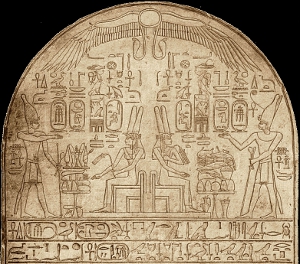Ahmose I (“the moon is born”) liberated Egypt from the Hyksos. It is thought that he was only ten years old when he assumed the throne. Both his father Seqenenre Tao and his brother Kahmose died fighting the Hyksos. Most scholars believe that his mother, the powerful Queen Ahhotep, acted as his co-regent for the early part of his reign and retained a great deal of influence with the king. He also relied heavily on sister-wife (Queen Ahmose Nefertari) and his grandmother (Queen Tetisheri) for support, and honoured their names throughout his reign.

Much of the information we have regarding Ahmose has been gleaned from the tomb of Ahmose, son of Ibana. He had a detailed autobiography inscribed in his tomb, and, as an officer in the Egyptian army, he was well placed to provide us with details of the king’s campaigns. Apparently the early years of his reign were fairly quiet, and the Hyksos may even have made some gains. However, he resumed hostilities about half way through his twenty-five year reign launching attacks on Hyksos strongholds including Memphis and Avaris and retaking Heliopolis. He laid siege to the Hyksos fortress at Sharuhen for six years, at last forcing them to retreat. The king then led his army to Nubia (Kush) imposing his control as far as the Second Cataract and installed a Viceroy in Buhen to manage the area.
While Ahmose I was in Nubia, Hyksos sympathisers led by Teti-en tried to seize the throne. However, his mother (Queen Ahhotep) quashed the rebellion and maintained power until the return of her son. For her bravery, the Pharaoh awarded her “the gold flies”. The king then returned to Palestine, pushing as far as the Euphrates, to make it clear who was in charge. On returning home, he seemed content to allow local governors to get on with their jobs, rather than imposing central authority. He also encouraged support for his rule with gifts of land, and was careful not to forget those who had helped him regain control of Egypt. He did undertake some temple reconstruction at Abydos, and reopened the Tura limestone quarries, but left little mark outside Thebes. However, recent digs have found evidence of his palace in the Al-Dabaa area, close to the ancient Hyksos capital.

Ahmose I married his sister, Ahmose Nefertari, and the couple were blessed with a number of children. Two of their sons died at a young age (Sapair and Saamen), but the third went on to become Amenhotep I. As well as honouring his mother, the king clearly respected his powerful sister-wife. She already held the title, “Second Prophet of Amun”, an exceptional rank for a woman, and he gave her the title “God’s Wife of Amun”. This begun the convention of naming the chief wife of the pharaoh by this title.
He was apparently buried in the Dra Abu el-Naga area, but his tomb has not been located. His mummy was reburied in the Deir el-Bahari cache (to protect it from tomb robbers) in antiquity. However, he did construct a cenotaph at Abydos, composed of two temples, one against the cliff and one on the edge of the Nile, and a small pyramid. The pyramid is the last known royal pyramid in Egypt. Inside the pyramid the pharaoh appears in a series of battle scenes which include some of the earliest depictions of horses in Egyptian art.
Names and Titles of Ahmose I


- Manetho; Tethmosis (Josephus), Amos (Africanus), Amoses (Eusebus
- Horus name: Aakheperu
- Nebty name: Tutmesut
- Golden Falcon name: Tjestawy
- Nomen; Nebpehtire
- Nomen; Iahmes, Ahmose
Bibliography
- Bard, Kathryn (2008) An introduction to the Archaeology of Ancient Egypt
- Bourriau, J (2000) “The Second Intermediate Period”, in The Oxford History of Ancient Egypt Ed I. Shaw
- Dodson, A and Hilton, D. (2004) The Complete Royal Families of Ancient Egypt
- Kemp, Barry J (1991) Ancient Egypt: Anatomy of a Civilisatio
- Rice, Michael (1999) Who’s Who in Ancient Egyp
- Van De Mieroop, Marc (1999) A History of Ancient Egypt
copyright J Hill 2016